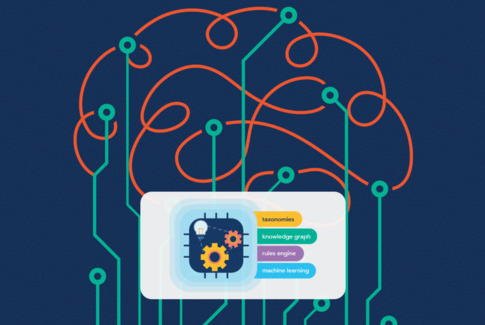
The most accurate language understanding systems rely on enterprise knowledge to solve business problems of any complexity. Applying such knowledge is foundational to the symbolic AI approach that excels at horizontal use cases such as text analytics, cognitive processing automation (CPA) and smart customer interactions.
Typically stored in a knowledge graph, this knowledge takes the form of vocabularies, taxonomies and rules. Such elements provide consistent definitions of terms so their meaning is clear, while rules supply a means of reasoning through this knowledge so that systems actually understand the text they encounter.
There are two types of knowledge used in language understanding systems:
- Explicit knowledge is transparent and obtained by easily understood, explainable means (e.g., an expert providing taxonomies). For example, anyone who looks at definitions of product names in a knowledge graph can understand what they mean throughout an entire business unit or enterprise.
- Implicit knowledge is less transparent and more difficult to explain. When someone is performing a task, they are acquiring and displaying implicit knowledge. In fact, individuals may not even be aware that they are acquiring these skills nor able to explain them…or how they acquired them. A classic example of implicit knowledge is knowledge represented in deep neural networks. This is implicit knowledge because it is not transparent and impossible to trace or understand in a precise way.
The application of explicit knowledge consistently provides the most accurate results for language understanding systems. Those explicit means can involve symbolic AI and statistical approaches, including machine learning.
Expanding Upon Explicit Knowledge
Explicit knowledge is the most basic form of knowledge, and is easy to pass along because it’s written down and accessible. Obtaining knowledge via explicit means is an approach specifically designed for language understanding applications. This process involves reading through documents, understanding their content and extracting relevant knowledge to enrich a knowledge graph that stores this information. Organizations can employ manual approaches or automated ones to assemble this knowledge.
Explicit Knowledge and NLU
There’s a rich history of using explicit knowledge for language understanding systems. As a discipline, artificial intelligence is rooted in this knowledge-based approach. It was actually the first approach to be applied to language understanding, as opposed to statistical machine learning methods. Since symbolic AI is tailored for language understanding, it is not used for other types of AI like image recognition.
Implicit Knowledge and NLU
Since implicit knowledge is acquired experientially and is more difficult to explain, it is hard to unpack. Currently, intricate, multi-layered neural networks capture and store knowledge in an implicit way. This is especially true of those applied with the compute power and scale of deep learning. The most implicit means of gaining knowledge for language understanding systems include the use of convolutional neural networks, graph neural networks, transformers and bi-directional encoder representations from transformers.
The knowledge gleaned from these techniques is implicit because of the black-box nature in which they learn. The benefit of this approach is it’s fully automated, saves time and can accrete knowledge. The challenge is it’s difficult to pinpoint exactly what is learned from these implicit techniques.
In production, purely model-driven approaches to language understanding tend to analyze text according to the data they are trained on—which isn’t always the same and can create inaccuracies. There’s also less control over what models learn, which might include expletives, politically incorrect terms or inaccurate information.
These models have so many parameters, hyper-parameters and weights that it’s difficult to validate or explain model results, which makes them difficult to qualify. The only alternative is to retrain them with more data.
“The implicit approach is not expressly designed for language understanding.”
This applies more broadly to AI in cases such as computer vision. Since the knowledge it offers is implicit, it doesn’t always provide the best results specifically for language understanding.
Explicit Knowledge from Machine Learning
However, other forms of machine learning deliver explicit knowledge. The aforementioned deep learning methods are considered advanced machine learning. Classic or traditional machine learning furnishes explicit knowledge by learning in a more transparent and explainable method. Traditional machine learning approaches include techniques like decision trees and straightforward regression models.
Additionally, there are proprietary algorithms expressly designed for enriching knowledge graphs in an explicit manner for language understanding. These algorithms are specific to knowledge enrichment and not other aspects of natural language technologies like language generation or speech recognition.
The Knowledge Graph Proposition
As one of the cornerstones of symbolic AI, knowledge graphs are integral to using explicit knowledge for language understanding. They store data in an explicit, declarative manner in which the data describe themselves via semantic statements/relations called triples. These statements contain a subject, predicate and object about what each datum is. Thus, this knowledge is easy to see, understand, modify, link to in the graph and enrich with additional knowledge—which is why it’s called explicit.
For example, knowledge graphs can create links between business concepts (e.g., specific services for credit cards, savings accounts, commercial loans, etc.) which users can explore to understand what these things are and how they interrelate. Also, by following the business rules contained in knowledge graphs, anyone can understand the decisions made by language understanding systems because they’re easily traceable, explainable and explicit.
Explicit Machine Learning Benefits
With these machine learning methods, organizations can conserve time and manpower and automate the assembly of explicit knowledge. These results are immediately discernible on a knowledge graph, making them easy to correct. They can also serve as a potent reinforcement method by indicating that more knowledge about income information is necessary (e.g., for a mortgage application).
The best results come from iterative processes in which they analyze text, extract information and illustrate what can be learned from it. Once that’s put into the graph, users can analyze it again to find additional elements or parameters that increase the knowledge gained—like a form of auto-tuning.
Key Takeaways
The key takeaway is that explicit knowledge can optimize language understanding systems via both symbolic AI and machine learning. Together in a hybrid approach, these methods blend the sound reasoning of the former with the automated knowledge assembly of the latter.
As a result, users get explicit knowledge that is traceable, understandable and usable by any language understanding application—with better results than purely implicit knowledge provides.


